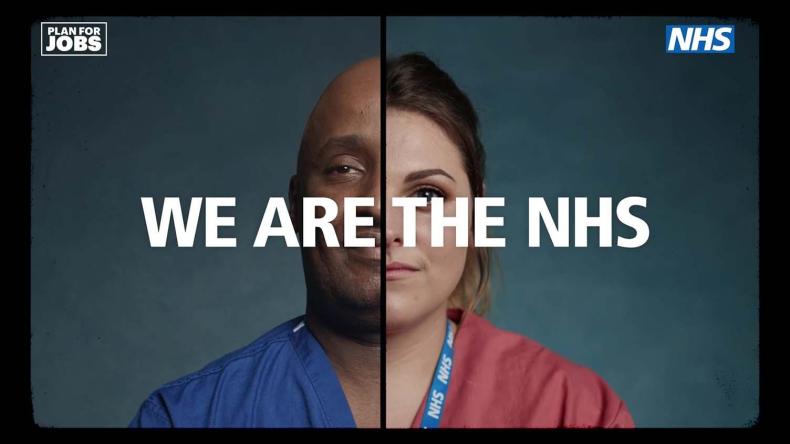Throughout you will find guidance, good practice, checklists, top tips and thought-provoking questions. These are designed to help you reflect and consider what you and your organisation can do, along with practical information on how to get started. You can use the chapters menu at the bottom to explore the different sections and topics.
Background
As the world’s fifth largest employer, workforce supply is a top priority for the NHS. Despite its 1.2 million employees in England (1.7 million including Wales, Scotland and Northern Ireland), staffing shortages across some professions exist, which impacts on the delivery of essential services.
The 10-Year Health Plan, published in 2025, sets out how the NHS will address existing and future workforce challenges.
Its aim is to reinvent the NHS through 3 radical shifts:
- hospital to community
- analogue to digital
- sickness to prevention
It also outlines the target to have an 'NHS workforce, fit for the future', by creating a model with staff genuinely aligned with the future direction of reform. A separate 10-Year Workforce Plan is expected to be published in spring 2026.
The materials, resources and guidance in this toolkit can help you and your teams to develop ways to implement the 10-Year Health Plan.
The NHS must ensure that health and care remains an attractive and accessible sector for local talent. It is crucial for organisations to develop relationships with education providers, influence the skills agenda and ensure visibility as a good employer within the local community.
It takes time and investment to grow new talent. The information throughout will help you as you take stock of what you might want to do now, to ensure you are able to sustain your workforce pipeline.
Our inspire, attract and recruit webinar runs through the toolkit's contents and gives you an overview of the types of information and good practice examples you will find.
Use the +chapters navigation menu at the bottom of your window or click on a chapter on the right-hand side of the page to explore the different elements of inspire, attract and recruit to make best use of this toolkit.
Inspire
Inspiring current and future generations to work in the NHS requires understanding how to be a trusted and committed employer and finding ways of connecting with communities to advocate the range of career opportunities.
Anchor institutions
Throughout this toolkit we refer to anchor institutions, and implementing the good practice contained here will help your organisation further establish itself in this role.
An anchor institution is a large organisation that supports the health and wellbeing of its local population through, for example, good employment opportunities and inclusive recruitment practices.

NHS organisations are anchor institutions and can play an important role in growing and strengthening the domestic workforce. In 2022, six NHS organisations were awarded funding to implement and test projects that aim to embed anchor practices and tackle health inequalities in their local areas.
Your staffing pipeline includes trainees, new graduates, those returning to practice and overseas candidates. Reducing net migration continues to be high on the government’s agenda and it is important that organisations strengthen local strategies to enhance domestic supply routes and continue to be an employer of choice.
A focus on widening participation and tapping into programmes such as Step into Health will help you become an anchor institution within your communities. Find out more about widening participation in the local community section under inclusive recruitment.
Workforce data
Your existing organisational workforce data will help to show what is happening, for example high turnover, and identify areas for improvement. This then needs to be considered and understood both at an organisational and team level to help inform future improvement activities.
Evaluation
Continual improvement of any practice requires ongoing evaluation and it is worthwhile building this into your recruitment activity from the beginning, considering what elements you want to regularly measure and how this can help improve your future activity.
Questions to consider:
Do you understand your trust vacancy rate data?
Do you have opportunities to plan across your local health system to understand and manage risk?
What’s your organisational workforce plan for the next few years and beyond?
Labour market trends and competition
The labour market overview report provides updated estimates of employment, unemployment, economic inactivity and other employment-related statistics for the UK.
While helpful to look at national workforce trends, it is also important you understand your own local workforce profile and patterns, and how this can impact recruitment.
In a competitive market, you should also consider the unique selling points your organisation has over other sectors, such as staff rights to request flexible working from day one of their employment. Understanding why candidates are choosing to work in other sectors will also help your organisation adapt in a competitive market.
The NHS is often the largest employer in a local community. Does all of your community see you as an employer for them?
Workforce redesign
Workforce redesign is about seeking new ways of working for your existing staff to develop their current skills and gain support in building resilience and confidence; meeting the needs of new organisational systems and processes to improve patient care.
The Nursing Associate role was introduced in 2017 and there are now a number of routes for entering the profession. Our infographic above sets out the different routes available for organisations to develop nursing associate roles and any costs for employers.
Additionally, you can view our guidance about how to train, fund and deploy nursing associates, as well as the benefits they can bring to your organisation.
There are also a number of infographic pages about other types of healthcare roles with different route options for entering the workforce:
Your audience
The audience you can inspire, attract and recruit from is vast. From school children and students in higher education, those already employed in other industries and sectors, to ex-Armed Forces personnel and your local community, it is worthwhile engaging as widely as possible.
Understand and communicate with different generations
It is important to recognise that communicating with potential new and young talent may need a different approach to that with older, more experienced individuals, but employers need to ensure that all demographics feel valued and rewarded.
Develop a strategy
Reach a broad audience
Using a mixture of communication channels enables you to reach a broad audience of different ages and backgrounds to maximise your reach to potential new employees.
Employee engagement is key
People want to feel engaged in their work and it’s worthwhile considering that one of the key factors affecting engagement is the degree in which staff feel valued and recognised by the organisation they work for and the people they work with.
Questions to consider
How do you communicate to your audience?
Have you considered that each generation has their own preferred communication channels?
Have you harnessed the skills and experience of your communications colleagues?
Is your recruitment part of a wider external communication strategy?
What skilled staff are looking for
Workforce shortages are seen across many professions. With nursing, medical and some allied health vacancies at record highs, have you thought about what professionals are looking for in a role and what is likely to make them stay?
Retaining staff
Many organisations carry out stay interviews to better understand why current employees work in the organisation and what might cause them to leave. These can take place periodically either in an informal or formal setting and managers should feedback key themes, so the data can be used to inform initiatives to aid retention.
Our toolkit: Improving the retention of registered nurses and midwives, enables organisations to undertake a self-assessment against the seven elements of the NHS People Promise. It aims to support those involved in the retention of registered nurses and midwives.
NHS England has also published a staff experience assessment tool to support staff to deliver high quality care, enhancing job satisfaction and supporting the retention of nurses and midwives. The self-assessment tool can be used by anyone responsible for the retention of nurses and midwives. NHS England recommends completing the tool alongside your nurses and midwifery retention steering group or equivalent, and involving a wide range of colleagues.
NHS Staff Survey
Another tool you have available to you is the annual NHS Staff Survey. Read our briefing which analyses the latest survey results and identifies the key workforce related issues and trends.
Further detailed information and data about the latest national and local survey results can be found on the NHS Staff Survey website.
Questions to consider
Do you know what your staff would like from your employment offer?
How do you use this to inform your future recruitment?
Return to practice
It’s worth considering who in your local community may be eligible to return to practice and the national schemes available to help you attract and recruit from these groups. Read our guidance on return to practice for healthcare professionals.
Read our flexible retirement guide which focuses on supporting nurses to access flexible retirement. It outlines the benefits of flexible retirement and showcases what it can look like in practice.
Dorset Healthcare has demonstrated how to be a flexible employer by supporting working carers to stay in work. It has created a culture where carers feel able to discuss their situation and empowered to work with their manager to find solutions, without the risk of judgement.
School children and students
If you ask young people about careers in the NHS, many will be able to tell you about nurses and doctors, but few know of the wide range of opportunities available.
The NHS consists of many exciting careers. This section has a range of information about nationally led activities available and how you can use these to actively engage with, educate, inspire and support the young workforce of the future:
- Collaborating with schools and colleges can be very beneficial in encouraging students to take up a career in the NHS. Read our case study to see how NHS trusts are successfully working with Windsor Academy to complement how education and healthcare work together. You can also find out more by watching the recording below from our 2024 workforce supply conference.
- The Health Careers website lists a number of facilities around the country that allow school and college students the opportunity to see what it’s like to work for the NHS.
- Work experience placements can provide a valuable insight into NHS roles for students and young people. Our work experience hub draws together important resources and good practice examples from across the NHS. A case study by Mid Cheshire Hospitals looks at the redesign of their work experience programme which has reduced impact and burden on staff.
- It’s also worth considering students including those who may not have considered a career in the NHS, but who find themselves in the university clearing process (available from July to September each year).
The section below also details some different options available for young people in the NHS.
Local community
Recruiting from your local community and being inclusive in your recruitment can be hugely beneficial in helping you tackle your supply challenges. By making sure your recruitment is visible, open and accessible, your teams will be more innovative and creative. Good practice examples can be found in the recruiting from your local community resource page.
Have you considered how to combine your local community engagement opportunities with career promotion?
A potential talent pool of candidates, who could be underrepresented in your current workforce, lies within your local community. It’s worth considering how your organisation can engage with, attract and employ from this pool. Ex-offenders, care leavers (those who have been in care), refugees, the armed forces community, and those who have experienced homelessness are just some examples.
Partnership recruitment in Greater Manchester
A blog by Greater Manchester ICB looks at the socio-economic benefits of large scale and hyper-local recruitment and also details how cross-sector events are providing career opportunities and skills development to local people.
At our 2024 workforce supply conference Sue Howard, Head of Workforce Development at Greater Manchester, talked about how to make partnership recruitment successful. See what she had to say below.
Inclusive recruitment
Being an inclusive employer involves extending opportunities to individuals from all backgrounds by creating an open and accessible recruitment process that removes barriers and biases which may prevent individuals from underrepresented groups from applying or being successful. There are a variety of examples of what inclusive recruitment in the NHS can incorporate.
Our widening participation hub brings together information and resources on anchor and system approaches to employment, training and skills in health and care. We also have a number of good practice examples:
- Read how one ICS has introduced a number of different employability support channels to attract, recruit and retain local people with the right skills, values, and capabilities.
- An inclusive recruitment podcast series features interviews with Sandwell and West Birmingham NHS Trust and a senior manager at NHS England and Improvement. They share their experiences of inclusive recruitment practice, how they have made their processes inclusive and the benefits they have seen by doing so.
- Another way to make processes more inclusive is by embracing new technology to enhance or support some methods. This case study explores how University Hospital Southampton NHS Trust introduced a new concept using voice-enabled technology in job applications.
Refugee recruitment
- Our refugee healthcare professionals resource can support employers with the recruitment of skilled healthcare refugees.
- Read a blog by the West London NHS Trust describes how they are using an employment programme to help refugees living in local areas to find work. A supporting webinar also provided further detail and updates about this project.
- Leeds Teaching Hospitals NHS Trust and local charity Growing Points collaborated on the Hidden Talents project, aimed at helping people from disadvantaged backgrounds, principally refugees and asylum seekers, into work. The initiative was a great success and positively impacted both the trust and local community.
The Armed Forces community
There are approximately 950,000 working age veterans in the UK and 14,000 leave the Armed Forces each year. Many of these individuals are job ready and contribute to a pool of staff your organisation can tap into.
Armed Forces personnel undergo extensive training and development which leads to a wide range of qualifications and transferable skills, combined with values that are closely aligned to the NHS.
Step into Health is a programme that connects employers in the NHS with the Armed Forces community. Organisations pledge to the programme and enhance their recruitment processes to make them more accessible to this talented pool of candidates. Step into Health-pledged organisations also have access to an online candidate system where they can get in touch with interested candidates.
Our Armed Forces Reservists toolkit offers practical guidance to managers in NHS trusts to understand and develop a structure of support that can be offered to reservists in the workforce.
Shared learning from Ashford and St Peter’s Hospitals NHS Foundation Trust
Ashford and St Peter’s Hospitals has led the Surrey and Heartland STP to sign up to Step into Health as a collaborative. The STP has jointly funded a project lead role who will coordinate all the activity between the 11 health and social care organisations in the footprint. This collaboration allows each employer to benefit from the relationships built and expand their reach to the Armed Forces community.
Overseas candidates
Overseas recruitment has made a valuable contribution to the NHS over recent years. The NHS Long Term Workforce Plan underlines the importance of ethical international recruitment as an important element of NHS workforce supply alongside other longer-term domestic education and training solutions.
If you haven’t already, it’s worthwhile considering how you can help your overseas professionals to meet the necessary requirements and prepare them to come to the UK. Sign up to our international recruitment network to keep up-to-date with the latest developments, join a safe environment to share current experiences and best practices, and network with colleagues across the NHS.
For the latest webinar on international recruitment (delivered by the Home Office), you can view a recording on our information page on how immigration changes and eVisas will impact recruitment from overseas.
You can find a host of information and guidance on the international recruitment section of the website. Here you will also find our interactive international recruitment toolkit, designed to help employers effectively plan and ethically recruit from overseas. Additionally, our international retention toolkit supports a reduction in turnover of international staff in the NHS by enabling them to stay, thrive and build lasting careers.
Take a look at how Solent NHS Trust has worked on improving international recruitment and retention rates for mental health nurses.
Employers should familiarise themselves with the UK Code of Practice which promotes high standards of practice in the international recruitment and employment of healthcare professionals.
Inspire top tips
-
Identify your organisation's unique selling points and hone in on these in your recruitment materials.
-
Assess how your organisation communicates its employment offer to prospective staff. Using a varied range of communication techniques can help ensure your offer is communicated as widely as possible.
-
Understand what your existing staff like about working in your organisation and what things may cause them to leave. You can do this by carrying out 'stay' and 'exit' interviews.
-
Use national schemes to help you design your retire and return offer. This can help you retain the expertise of experienced staff for longer.
-
Partner with local schools and colleges. By actively engaging with these institutions you can help inspire a future workforce.
-
Ensure your recruitment is visible, open and accessible. This will help you to access all the talent in your local community and recruit more widely.
-
Offer apprenticeships, traineeships and pre-employment programmes as alternative access routes into your organisation.
Are you tapping into Jobcentre services?
Jobcentres provide specialist services and solutions for staffing and assist with recruiting from local communities. They can share info on local careers/job fairs which you may wish to attend to highlight opportunities in your organsiation. They can also help with job trials and provide guidance about employing individuals with disabilities.
Our information page has lots of detail on the above plus more.
Find contact details for your nearest jobcentre(s) on the GOV.UK website.
Attract
Attracting staff in a competitive environment during a digital revolution can feel overwhelming. It can be confusing what methods of recruitment best suit your organisation and difficult to stay ahead of emerging trends.
From profession-specific videos shared on social media, to hospital open evenings and celebratory events, there is lots that can be done to raise the profile of your organisation and the career opportunities on offer.
In this section you can find a range of attraction methods along with resources and leading examples.
NHS Employers facilitates a Recruitment Exchange Network for recruitment leads in the NHS. The network is a space for recruitment and resourcing managers in the NHS to share challenges and solutions with one another, test ideas and form a virtual support group. This network predominantly focuses on domestic recruitment and improving recruitment processes. Sign up to the network.
In 2025 the NHS Employers Workforce Supply virtual conference focused on how workforce supply and development strategies can support the ambitions of the 10 Year Health Plan. Speakers shared good practice and experience about the importance of collaborative, system-wide partnership working; and investing in local recruitment to build a resilient, future-ready workforce that supports the wellbeing of our communities. Reflections and recorded snippets from the conference can be accessed on our website.

We are the NHS
We are the NHS is a national recruitment campaign run by NHS England. More information can be found on the NHS Health Careers website.
Questions to consider
How is your trust perceived by your local community and beyond?
Is there more that than can be done to improve the reputation of your organisation?
What is your staff survey telling you?
What do prospective candidates think of your organisation at interview?
What do staff get in other trusts that they might be missing from yours?
Have you analysed the data from your stay and exit interviews recently?
A blog by Sussex Partnership NHS Foundation Trust on Maximising Talent Attraction looks at the creative recruitment concepts they use to help with attracting the best pool of talent and shares ideas for other organisations to take forward.
Being a leading employer
To compete for talent in your local community, your organisation will need to be visible. When attracting the best candidates, you need to be able to separate your organisation from the rest. Jobseekers are no different to any other consumer – they are looking for the best deal. We know this means different things for different people, so it’s important to know your audience.
From a good reputation and culture, a strong health and wellbeing approach, to communicating your reward package effectively, individuals need to understand what is available to them both within the organisation and in the local area such as schools and transport links. Having a strong employer brand is incredibly important in a competitive environment.
Our guidance page explores how you can support the multigenerational workforce by launching an age-inclusive reward strategy to aid retention and attract new employees.
The benefits of a strong employer brand include:
-
increased awareness of your organisation and vacancies.
-
enhanced image in the local community and beyond
-
reduced recruitment costs
-
pride amongst your staff
-
improved retention rates.
Use social media
Correct use of social media can help you to strengthen your employer brand and attract quality talent to your organisation.
Social media platforms are informal and can help you to reach out to an audience who may not be aware of vacancies through other routes, and in some cases may not even be actively searching but thinks of your organisation when they are ready for a career move.

The next generation of NHS staff will have grown up using platforms such as TikTok, Instagram, X (formerly Twitter), Facebook and LinkedIn. More NHS organisations than ever before are using these platforms, not only to recruit but to actively engage with the community to help inspire the future workforce.
Social media top tips
-
Develop and refresh your social media strategy – include a social media calendar.
-
Share updates consistently and regularly but don’t overdo it.
-
Post eye-catching images and engaging videos.
-
Keep your posts brief and concise – research shows posts with fewer characters attract more views.
Use your existing workforce
When thinking about attraction, your existing staff are ideally placed to talk about their careers, your organisation and why the NHS is a great place to work. They could even help you attract new candidates, including family members, to apply.
Our staff development pathways guidance hub contains information, infographics and good practice about supporting staff development, ultimately helping to retain them in your workforce.
For specific examples take a look at our resource page, which explores mental health and learning disability nursing in the NHS and provides guidance on how to attract, train and deploy staff in these specialist areas.
Volunteers
NHS organisations can benefit from volunteers in different ways to support their needs. The resources below can help with planning and implementing volunteer recruitment.
NHS England has launched a website allowing prospective volunteers to find and apply for NHS and partner volunteering opportunities in their area using a simple postcode search. The site is free and easy to use for both recruiters and potential volunteers.
Read a case study about how Bradford District Care NHS Foundation Trust used volunteers to support their allied health professionals, offering a first step into an NHS career.
Volunteers' Week is a national initiative across all sectors and takes place in June each year. Look out for information on the website about the next event.
Inspiring the Future has an online matchmaking platform to connect schools and colleges with appropriate volunteers from a range of sectors and professions that match their requirements. There are currently more than 41,000 volunteers registered, and your staff can join them to help inspire young people. If you’d like to share how it works, share this short video with your staff.
Questions to consider
Do you encourage your existing staff to spread the word and become health ambassadors within your organisation?
Could you use inspiring the future or other similar schemes to elevate the workforce?
Profession specific videos
One way to help highlight your organisation to potential employees is by showcasing some of your current workforce. Here are some leading examples of trusts using videos and their staff to highlight the benefits of working for them.
Open days and events
Open days, recruitment fairs and exhibitions are a fantastic way to attract and inspire young people and the local community to think about a career in the NHS. You can set up a stall in your hospital foyer with your staff, who can share their career journeys and answer any questions.
Many trusts run open days during celebrations weeks such as Healthcare Science Week.
Recruitment fairs and exhibitions, such as the yearly Big Bang fair, is a fantastic way of targeting a big audience and promoting your organisation as an employer of choice. Coordinate your attendance at these events with neighbouring health and social care organisations to prevent duplication and reduce resource allocations.
Celebratory weeks
Every year, dedicated healthcare celebrations and awareness weeks provide a fantastic opportunity for you to raise the profile of NHS careers.
One of these is Healthcare Science Week in March, when organisations across the country celebrate healthcare science and the various routes into the profession.
Find out what has taken place previously and how you can get involved in the next celebrations.
View more days and events on our calendar of national campaigns.
Rotational roles
Rotational roles are a great recruitment incentive, particularly for newly qualified staff who are keen to expand their skills, knowledge and experience. Rotational roles can be offered within an organisation or collaboratively across trusts in your region. Not only can they help you strengthen your employment offer, they also facilitate shared learning between departments and organisations, upskill staff and help with retention.
Internal transfer schemes
Offering staff routes to develop their careers in other parts of your organisation can be a great method for attracting and retaining your workforce. Often referred to as internal transfer schemes, these arrangements can allow staff to make a sideward move into a department they are interested in, allowing them to expand their knowledge, skills and experience – without the burden of re-applying for a role and going through a recruitment process.
I have found that it’s so beneficial to have knowledge from other areas and fresh ideas and new ways of working – it only enhances your nursing care.
Flexible working
The UK workforce is now more diverse than ever, reflecting changes in society and demographics of the population. Flexible working opportunities and predictability of shifts can support the delivery of improved service outcomes, providing benefits for the organisation, individual and the patient. It can provide an attractive offer to staff, many of whom have varying commitments which can make it difficult working certain hours. By offering flexible working, you can attract a pool of applicants which may otherwise have not been attracted to roles in your organisation. We are aware that it may be difficult to offer flexible working patterns in certain circumstances. To help you work through common challenges, we have published a set of scenarios that offer potential barriers to flexible working and the solutions to these. In addition we have produced a mythbusting resource to further help with any issues.
Our flexible working infographic highlights the range of flexible working options available to NHS staff.
NHS England, the NHS Staff Council and Timewise have also published two guides to support line managers and staff work flexibly.
Communicate reward and recognition
Communicating the whole reward package is a key part of recruitment. Read our article which outlines the benefits of employee recognition and how your organisation can develop a recognition strategy. Our webpage and the infographic below also show how using the right technology can help you promote the benefits of working for your organisation to potential new employees and existing staff. Additionally, you can use our reward communications guide to help you plan and communicate your organisations’ reward package to staff.
Line managers also play an important role in communicating reward benefits to staff. Our webpage provides ways to involve them in developing your reward strategy.
Our Reward and Recognition Network brings together NHS colleagues, with an interest in reward, to share knowledge and experience. Joining the network can help you to develop your local reward package and strategy by gaining inspiration and ideas from other organisations.
You can find two good practice examples on our website:
- read about the major benefits Midlands Partnership University NHS Foundation Trust (MPFT) saw by putting culture first and improving its reward and recognition initiatives.
- take a look at how Mid Cheshire Hospitals NHS Foundation Trust (MCHFT) created an employee value proposition brochure to showcase its employment offer.
For line managers wanting further support with communicating their organisation's offer we have created a resource page and template to help with this.
Find more reward resources and how to develop a reward strategy on the NHS Employers website.
NHS Pension Scheme
The NHS Pension Scheme continues to be one of the most comprehensive and generous schemes in the UK and is a key part of the reward offer for NHS employees. It is a valuable recruitment and retention tool for employers to use.
In 2024, the Department of Health and Social Care (DHSC) implemented changes to the NHS Pension Scheme to help employers to attract and retain valuable experienced staff, maintaining the capacity required to deliver high quality patient care.
Our NHS Pension Scheme poster communicates the value of the scheme and shows six of the key features that staff told us are most important to them. Including the poster in job adverts is an easy visual way to promote the scheme benefits to potentials new employees. Use the resource to support your conversations with staff about pensions and to help you explain the benefits of being a member of the scheme. Our benefit leaflet template is also useful for designing a leaflet to showcase and promote your reward offer.
Awards for recognition
Have you considered using an award scheme?
Leeds Teaching Hospital Foundation Trust have introduced award programmes to recognise their staff. Read Katy Mallender-Ward's blog to find out more.
Essex Partnership University NHS Foundation Trust set out to revise its existing staff recognition scheme, with the aim of strengthening its culture around recognition to make it more meaningful for staff. Take a look at the case study which explores how the trust developed several award categories.
Careers resources
The Health Careers service provides an inclusive hub of NHS career information about the 350+ opportunities available, along with useful resources including infographics and posters to help employers inspire the future workforce.
Health Careers also runs an annual Step into the NHS campaign which provides 12-14-year olds with careers information as part of the Key Stage 3 curriculum. They can also support you to offer work experience to people from underrepresented communities. Access their smart guide.
Questions to consider
What do you do to support applicants?
Is providing support something that might be valuable in your organisation?
Why not start the conversation with your senior leadership team?
Employability programmes
Employability programmes support individuals to help them secure employment. Many people who are unemployed face difficulties and barriers when seeking employment. The reasons for this are quite complex and might include:
- Low confidence and self-esteem
- Gaps on their CV
- Negative work experiences and lack of recent work
- Out-of-date core employability skills
- Stigma around mental health
Find out about the approach Birmingham Children’s Hospital has taken to supporting young people on their career journeys in its Aspire programme.
Attraction top tips
-
Ensure your website is engaging and provides individuals with up to date, concise and inspiring information about your organisation and this surrounding area.
-
Provide clear information on the various opportunities and routes into your organisation.
-
Consider an employability programme and how you can support people into your organisation.
-
Describe your reward package and the benefits you provide.
-
Use social media to promote your organisation and inform the community about open days, recruitment opportunities and how individuals, schools, colleges and universities can get involved.
-
Consider creating engaging resources to inspire your audience such as profession-specific videos which describe the career journey and inspire people to work for you.
-
Encourage your current staff to spread the word about the NHS and the range of opportunities available.
Recruit
Recruiting is much more than writing job descriptions, interviewing and carrying out pre-employment checks. Each step is as important as the next and it requires planning, clear processes and agreed timescales.
Have you looked at previous exercises and taken feedback into account? Of those interviewed and made appointable how many took up post? How long did the process take and if they didn’t end up starting in role, do you know why? A review of this can help you identify any areas for improvement and prevent this pre-start attrition.
Recruitment needs to centre around a positive candidate experience. It needs to provide all potential employees with a quick and easy route to finding a vacancy and applying, which swiftly leads to a stimulating and fulfilling interview with an appointment offer, or notice made as soon as possible if they’ve been unsuccessful. This streamlined approach helps to ensure potential recruits feel engaged, motivated to continue with their application, aren’t side tracked by another offer and have the confidence to re-apply once ready.
When a potential recruit spots your vacancy, ideally you want them to find out more about your organisation. Having your own careers website which is engaging, informative and enticing is key. Scroll to the advertising chapter of the toolkit to find out more.
It is also important to consider that many people search and often apply for vacancies using mobile technology. Studies by Glassdoor suggest that without mobile access, you could cut out nearly half of your potential candidates.
Questions to consider
What is the recruitment experience of individuals who apply to work in your trust?
Could it be improved?
Is your own job section of your trust career website mobile-ready?
Positive action and accessible recruitment
Taking positive action during the recruitment process can enable you to diversify your workforce, and deliver against actions in the NHS Long Term Workforce Plan, Workforce Race Equality Standard and the Workforce Disability Equality Standard.
The government’s Equality Act 2010 quick start guide states:
"Positive action provisions mean that it is not unlawful to recruit or promote a candidate who is of equal merit to another candidate, if the employer reasonably thinks the candidate:
- has a protected characteristic that is underrepresented in the workforce; or
- that people with that characteristic suffer a disadvantage connected to that characteristic.
However, positive action does not allow an employer to appoint a less suitable candidate just because that candidate has a protected characteristic that is under-represented or disadvantaged."
Protected characteristics include age, disability, gender reassignment, marriage and civil partnership, pregnancy and maternity, race, religion or belief (or lack of), sex, and sexual orientation.
Most fundamentally positive action can support employers under the Equality Act 2010 to recruit and promote people from underrepresented groups to help them overcome disadvantages in competing with other applicants.
The government's positive action in recruitment guide outlines all of the steps throughout the recruitment process where positive action can be taken and includes examples of tie-break scenarios. Your recruitment team can also provide you with data throughout the recruitment process about the protected characteristics of applicants, to support you with taking positive action during the process, or to understand where barriers in the process may occur.
Ensure that your recruitment processes are accessible to all too. Ask whether reasonable adjustments are required and if so provide them. This may be including hearing loops, accessible software for any computer-based activity, a wheelchair accessible space for all activities, papers in large print and colour filters available.
Interviews and selection
Interviewing has evolved over the years and employers are using a variety of methods to make the process quicker, easier, more accessible and more variable, all of which enhance the candidate experience. Virtual interviews are now a standard part of modern recruitment.
In-person interviews can be conducted at open days and exhibition events giving candidates a quick and easy recruitment experience while also saving time and resource in your organisation. To help widen your pool of applicants and manage the interview process in a resourceful way, some employers are choosing to carry out video interviews using Skype, or in some cases, pre-recorded interview questions which allow individuals to be interviewed at a time which suits them.
Recruit to retain
The first six months in a new role typically influences whether an employee stays for the long term, making induction and the onboarding process crucial.
An effective induction or period of preceptorship can help employees hit the ground running. Integrating staff into your organisation and setting out what is expected of everyone in a clear and consistent way can help the bedding-in process.
Effective mentoring, senior support, structured appraisals and a supportive learning environment are all effective ways of supporting new starters and will help staff to be as productive as possible in their roles.
For further good practice on how you can support new starters and other items that can help you to retain your staff for longer, read our Improving staff retention guide.
Read our tips on how to streamline your recruitment process for young people and reduce the delay between job offer and start date.
We also have information, resources and practical guidance for employers in being more age-inclusive towards older workers in recruitment processes and employment offers.
Recruitment processes
Recruitment takes time but there are things employers can do to help speed it up and ensure your prospective employees feel engaged from start to finish.
Streamlining between trusts helps to deliver a quality and efficient recruitment experience which reduces duplication and unnecessary delays in getting the successful candidate started in the workplace. It involves organisations working collaboratively to embed and deliver consistency through HR best practice and includes joint working between professionals from the four key HR workstreams; occupational health, medical staffing, statutory and mandatory training and recruitment.
Efficient recruitment processes that centre around candidate experience can help you to expand your talent pool, recruit quicker and improve your employer brand.
Delays in time to hire can be detrimental to candidates' experiences of the NHS and result in high dropout rates as they choose to seek employment elsewhere. Read our case study to find out how one trust has had successful recruitment events with a streamlined process, ensuring that multiple stages were completed on the same day, in turn reducing the time to hire.
Our recruitment processes pages provide guidance and examples from other NHS organisations on several topics that, done well, will help you improve the efficiency of your processes and keep you up to date with the latest trends in recruitment. These include:
- Automating recruitment processes – the use of robotic process automation (RPA) to programme software to take care of routine, manual processes, freeing up staff to work on more value adding tasks
- Virtual recruitment – helping you identify key considerations to make before, during and after interview when recruiting remotely.
Artifical Intelligence (AI)
Employers are seeing an increase in candidates using AI tools (for example, ChatGPT) to help them complete application forms. Our guidance page provides information to help employers understand the challenges and approaches to take when candidates use artificial intelligence (AI) in job applications.
A recent webinar, delivered by counter fraud specialists, explores the potential AI fraud and security risks faced within recruitment processes.
Pre-employment checks
Pre-employment checks are an essential part of recruitment and it is important they are carried out as efficiently as possible to avoid any delays in individuals taking up post. NHS Employers provides practical information, toolkits and resources on the pre-employment check standards including shared learning, which demonstrate how organisations have simplified checking processes without compromising standards and patient safety.
NHS Employers has also created an e-learning training resource which provides support with understanding pre-employment checks requirements, in turn helping to prevent barriers to employment and reducing the time to hire.
Our three-part series of webinar workshops exploring the different aspects of undertaking DBS checks provides in an in-depth oversight of this part of the process.
Reviewing recruitment top tips
-
Set clear recruitment objectives and targets.
-
Think about the evaluation methods available to you.
-
Track your website analytics, social media reach, media coverage tools and surveys.
-
Ensure you carry out stay and exit interviews and identify any trends.
-
Use staff feedback to identify trends.
Onboarding
New jobs are exciting but can also be a bit stressful for a new employee, so it is vital to consider the human factors that personally affect individuals during the first few months of beginning a new role.
Onboarding and induction done well can help you settle and retain the staff you’ve spent time and money recruiting. Get it wrong, and you could need to re-advertise and potentially damage your employer reputation.
Questions to consider
How do you help to onboard your staff?
What have you learnt from previous onboarding?
Can feedback from your new recruits help inform improvements?



